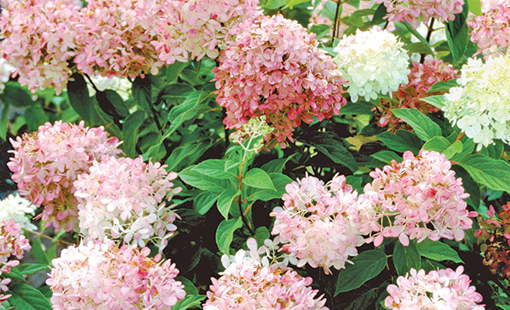
All About Limelight Hydrangea
Limelight hydrangeas are a popular and hardy flowering shrub with dramatic blooms that range from green to white to pale pink across a long flowering season. These are paniculata (orpanicle, referring to the shape of the flower trusses) hydrangeas, as opposed to macrophylla hydrangeas, and so they are more cold hardy and easier to grow. They’re very reliable bloomers, and the range of color from spring to autumn ranges from lime green to creamy white to dusty rose and even burgundy. The leaves also turn color in fall, becoming tinged with deep red. This color show is as elegant and thrilling as it is reliable, and looks great in a variety of landscape design styles, from traditional to modern. The blooms look very nice in the vase as cut flowers, and can also be dried for long lasting decor. Wait until they start to blush pink before cutting to dry them.
Care
Limelight hydrangeas can get quite large, so they make a good landscape specimen plant but they do need a bit of room to spread. They work well in a cottage garden, with their neutral colors and floriferous nature through three seasons. Hydrangeas don’t like to compete with other plants at their base so it’s best to avoid planting aggressive ground cover plants around them. Give them a good natural mulch like shredded pine bark. Avoid dyed mulches as these can encourage mildew growth.
Light
Paniculata hydrangeas do like some sun to bloom, but can be grown in partial shade. If summers are on the warmer side where you are, it’s best to choose a planting location with morning and not afternoon sun, as hot afternoon sun in the summer can cause the blooms to dry out. If you live in a colder zone, feel free to plant your hydrangeas in full sun, but avoid a windy spot.
Soil
Hydrangeas in general prefer a rich well-drained soil. For paniculata hydrangeas, a slightly acidic soil works well; you can achieve this by adding peat moss and or coffee grounds to the planting area. A pine mark mulch will also lend some mild acidity as it breaks down. If your hydrangea’s roots become exposed over time, add more soil and compost to keep them protected.
Water
Hydrangeas don’t normally require extra watering, but if there are more than a few days of drought in summer, give your hydrangea a good deep watering once or twice a week as needed to mimic rainfall.
Temperature & Humidity
This is a very hardy variety of hydrangea and can withstand cold winters. However it’s best to plant it where it won’t be vulnerable to damage from high winds. Hydrangeas don’t require any special humidity conditions. A muggy hot summer day may cause blooms to droop a bit; some cool water at the base may help.
Fertilizer
Hydrangeas benefit from light fertilization. Apply a granular “flower food” type fertilizer in spring, and again in late summer. Alternatively, some composted manure as a top dressing in autumn is also a good way to feed hydrangeas and keep roots healthy.
Propagating
It is fairly easy to propagate hydrangeas with branch cuttings. Choose a branch without a flower and cut about 6 inches. Dip the end in rooting hormone powder and plant in a light medium using perlite and potting soil. Water well and frequently, and cover with a plastic bag (placing sticks in the pot to keep plastic from touching the branch) to keep humidity high while the cutting grows roots, which should take from two to three weeks.
Pruning
Hydrangeas don’t need too much pruning. Some people like to leave the dried flowers during the winter on for their shape in the landscape. But you can snip them off while doing your autumn clean up if you like. Do trim them in spring at the latest. Remove dead wood and broken branches, and any suckers that pop up at the base of the shrub to keep your hydrangea looking neat and full. Be careful when pruning to not remove the buds which start forming early in spring. If your hydrangea shows signs of leaf spot, rust or mildew, trim off these affected areas to allow healthy growth.
Information courtesy of TheSpruce.com

 Adams Fairacre Farms
Adams Fairacre Farms